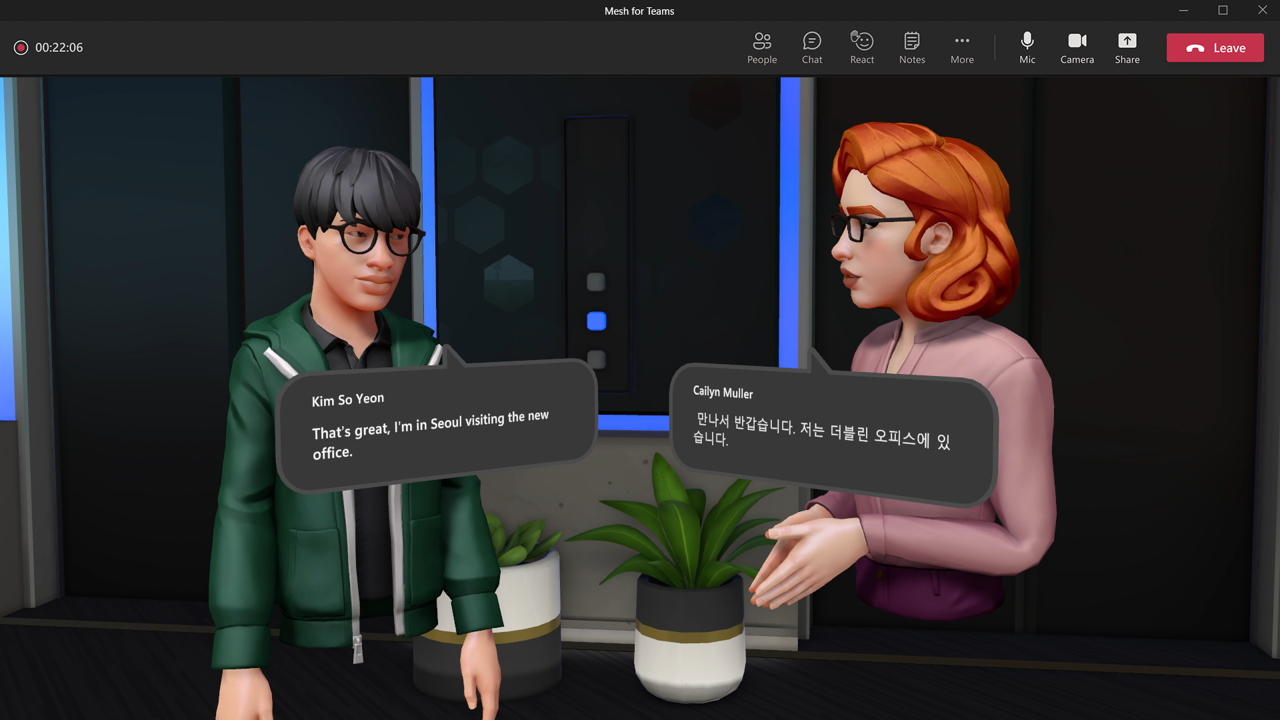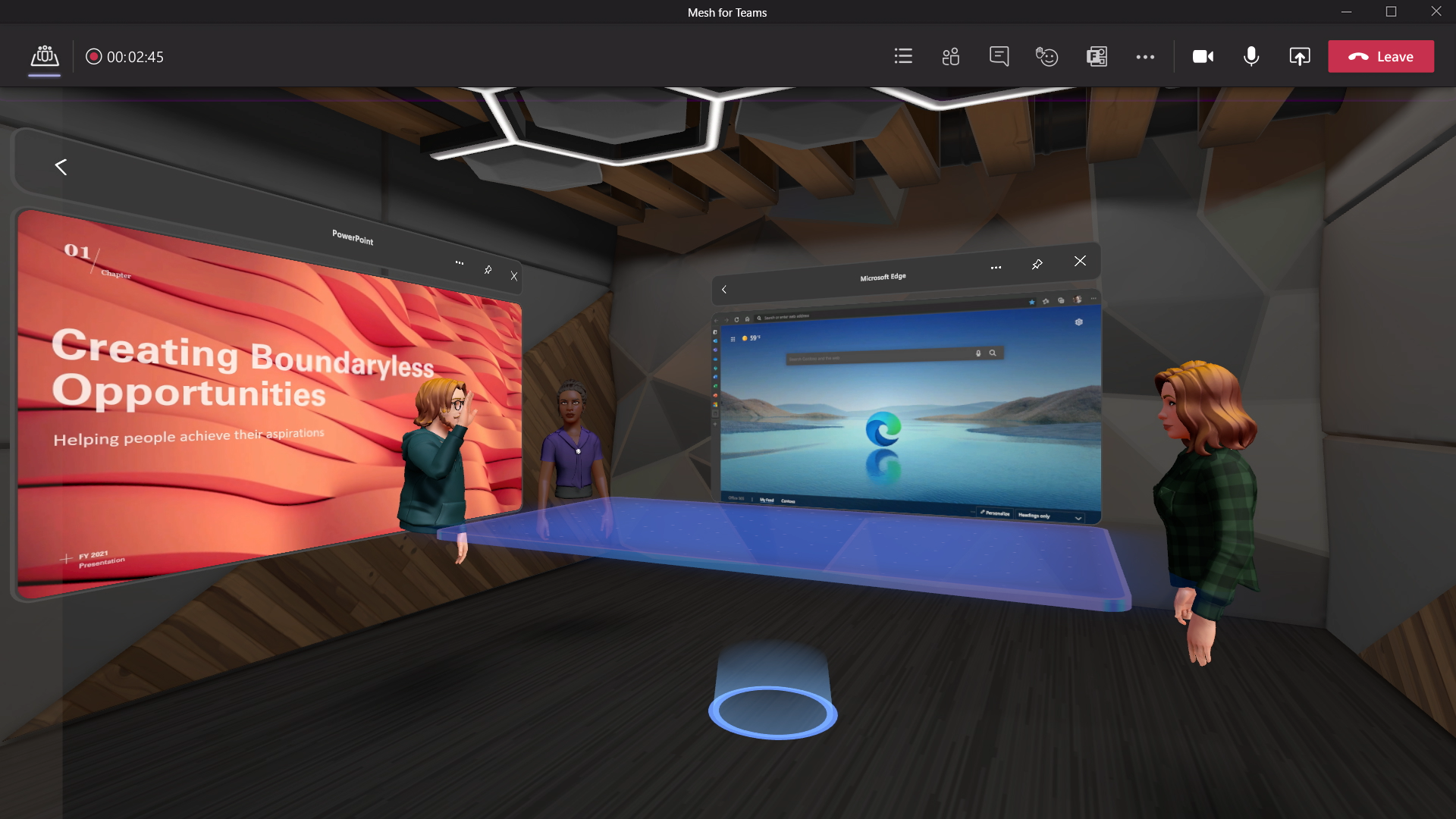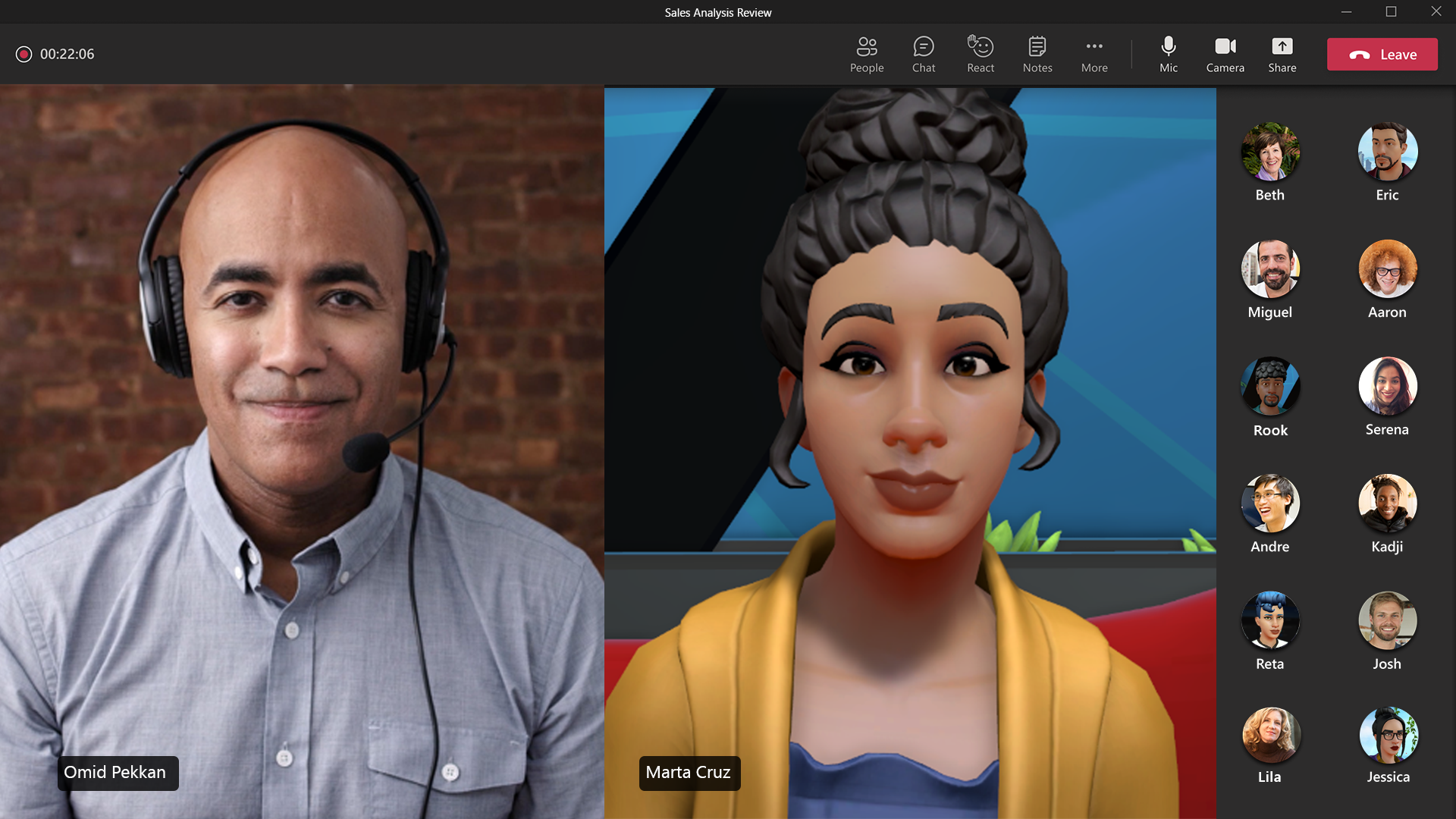More than a year and a half into a global pandemic that forced workers around the world to abandon their offices and learn to collaborate online, Microsoft productivity experts have observed two trends: remote workers are far more efficient than most business leaders ever imagined, and they miss each other. They miss hallway moments, kitchen catch-ups and chance encounters. They miss the body language from across the conference room table that says things that can’t be said.
In other words, the ability to work from anywhere and connect with colleagues online is awesome, but remote meetings can feel impersonal and lack the small moments that build relationships and careers. Ongoing studies in Microsoft’s research organization prove this out: people feel more present and engaged in meetings when everyone turns on their video cameras, for example. But the video option can be awkward and binary – on or off. Too many people, too much of the time, are a static picture or bubble with initials.
Microsoft today has unveiled a solution to this problem that begins rolling out in 2022: Mesh for Microsoft Teams. The feature combines the mixed-reality capabilities of Microsoft Mesh, which allows people in different physical locations to join collaborative and shared holographic experiences, with the productivity tools of Microsoft Teams, where people can join virtual meetings, send chats, collaborate on shared documents and more.
Mesh builds on existing Teams features such as Together mode and Presenter mode that make remote and hybrid meetings more collaborative and immersive, according to Jeff Teper, a Microsoft corporate vice president whose responsibilities include the Microsoft 365 productivity tools Teams, SharePoint and OneDrive.
These tools are all ways “to signal we’re in the same virtual space, we’re one team, we’re one group, and help take the formality down a peg and the engagement up a peg,” Teper said. “We’ve seen that those tools have accomplished both goals of helping a team be more effective and also helping individuals be more engaged.”
Mesh for Teams – which anyone will be able to access from standard smartphones and laptops to mixed-reality headsets – is designed to make online meetings more personal, engaging and fun. It’s also a gateway to the metaverse – a persistent digital world that is inhabited by digital twins of people, places and things. Think of the metaverse as a new version – or a new vision – of the internet, one where people gather to communicate, collaborate and share with personal virtual presence on any device.
The first step most users of Mesh for Teams will take is to join a standard Teams meeting as a customized avatar of themselves instead of as a static picture or on video. Organizations can also build immersive spaces – metaverses – within Teams. Mesh for Teams users can take their avatars into these spaces to mix and mingle, collaborate on projects and experience those serendipitous encounters that spark innovation.
“Welcome to Mesh for Teams,” said Microsoft Technical Fellow Alex Kipman. “As a company whose focus is on productivity, on knowledge workers, it’s something that customers are really asking us for, and it’s coupled with the vision of mixed reality that we’ve been working on for 12 years. It’s all coming together.”

Mesh for Teams users can take their avatars into immersive spaces to experience those serendipitous encounters that spark innovation. Image courtesy of Microsoft
On the Nth Floor
Kipman and his team have spent several years building Mesh-enabled immersive spaces with global professional services company Accenture, which has more than 600,000 people serving clients all over the world. Before the pandemic, for example, Accenture built a virtual campus where employees from anywhere could gather for coffees, presentations, parties and other events.
“We started to call it the Nth Floor, this magical, mythical campus that could only be found in virtual reality,” said Jason Warnke, senior managing director and global digital experiences lead for Accenture. His favorite feature, he added, is the ability to bump into colleagues from around the world and have deep and meaningful conversations. Jazzed after each event, he’d have ideas for five more.
Soon after the pandemic hit, the ultimate use case emerged: Onboarding new employees. Accenture hires more than 100,000 people each year. The onboarding process typically involves gathering new-hire cohorts and senior leadership in an office to go through a series of experiences that help people understand and personally connect with the Accenture culture, plant the seeds of professional relationships and set them up for success starting from their first projects.
Now, new hires meet together on Teams where they receive instructions on how to create a digital avatar and access One Accenture Park, a shared virtual space that enables immersive experiences during onboarding. The futuristic amusement park-like space has a central conference room, a virtual boardroom and monorails zooming off to different exhibits that each new-hire cohort goes through together.
“Right from the very start, you’re understanding what it’s like to work with this group of people who may be fully remote, trying to get something done,” Warnke said.
To date, tens of thousands of new hires have onboarded at One Accenture Park. Thousands more Accenture people have attended dozens of other events using laptops and virtual reality headsets in other virtual Accenture offices including a digital twin of Accenture’s recently opened One Manhattan West office in New York.
Learning to navigate the immersive spaces takes a few minutes, and then users are off and running, Warnke said. “All of a sudden, you’re looking at an avatar representation of someone, but you’re having these deep conversations about, like, ‘How is that big deal you’re working on? How is the family?’” he said. “You forget that you’re in a VR space. To me that’s the most magical part of what we’re doing here.”
On the spectrum of engagement
Mesh for Teams will roll out with a set of pre-built immersive spaces to support a variety of contexts, from meetings to social mixers. Over time, organizations will be able to build custom immersive spaces like the Nth Floor with Mesh and deploy them to Teams, noted Microsoft’s Teper. He envisions immersive spaces becoming one of the many ways people communicate and collaborate in addition to face-to-face meetings, chats, emails and video calls.
“We go through a spectrum of types of engagement depending on the situation and all are important,” he said. “We’re serious when it’s time to be serious. We’re celebratory when it’s time to be celebratory. We have fun and we goof off. And effective teams, effective human engagement, recognizes that we need to connect at a really personal level and go through that spectrum to build trust and empathy and fun and common purpose.”
An immersive space within a team’s channel on Microsoft Teams, he said, could serve to reinforce cohesion and common purpose. For example, a product design team within Microsoft might create an immersive space for its daily standup meeting. On one virtual wall might be customer pictures to keep the team grounded, while a whiteboard on another wall displays color-coded tasks. Product prototypes could be displayed on a table.

Avatars meet and collaborate in a Mesh for Teams immersive space. Image courtesy of Microsoft
“Being in that space together reinforces that sense of ‘Hey, we’re driving and driving toward a goal’ in a way that a meeting within the Brady Bunch grid without any of the recurring artifacts doesn’t,” Teper said. “The immersive space reminds us of the iterative purpose of our team. I think that’s how we can use this technology to break through.”
Better meetings on any device
The same branch of research that shows people feel more present and engaged during online meetings when their video is on has surfaced dozens of reasons why people leave their cameras off. These reasons range from privacy concerns and video fatigue to truths such as it’s hard to multitask while on video and, on some days, some people work in their pajamas but would rather not get called out for their attire during a late afternoon meeting.
“Sometimes I just want to be able to sit in my chair downstairs and have my heat pad on, but maybe it’s not that appropriate,” said Katie Kelly, a principal project manager at Microsoft working on Mesh for Teams. “I’d love to be able to turn on my avatar. I’m still present and engaged, and the people that are there feel like I’m present and engaged.”
When Mesh for Teams begins to roll out in preview in the first half of 2022, users will have a variety of options to choose from to create and join a Teams meeting as a unique, personalized avatar. Other attendees might also be represented by avatars, show themselves on video or use a static picture or bubble with initials.
“To start, we will take audio cues so as you talk your face will animate,” Kelly said. “You’ll also have animations that bring additional expressivity to the avatars. Your hands will move. There will be a feeling of presence even though it’s as simple as being able to take your audio and manifest that as facial expressions. That’s the first release. The ambition is to closely follow that with Microsoft’s plethora of AI technologies so that we can use the camera to insinuate where your mouth is and mimic your head and facial movements.”

There are dozens of reasons why people keep their video cameras off in meetings. With Mesh for Teams, people can join a meeting as a personalized avatar. Others may show themselves on video or a static picture, as shown in this example. Image courtesy of Microsoft
The experience will continue to evolve over time as sensor technology improves across devices, from phones to virtual reality headsets, from laptops with a single microphone to a HoloLens with six microphones and 16 cameras. Whatever the device, the mixed-reality technology will give each user an avatar that provides a sense of presence, that allows them to be their expressive selves when they don’t want to be on camera.
These avatars, Kelly added, are just the start. They’ll follow users from the Teams meeting to other Mesh-enabled experiences including immersive spaces within Teams, such as Accenture’s Nth Floor. “The idea is that you aren’t locked into this 2D interaction with your avatar,” she explained. “After I’ve formed a relationship with you, I know your avatar, I go into an immersive space that maybe has 20 other people in it. I’m going to see you in a corner and go, ‘Hey,’ and be able to go have a conversation.”
Gateway to the metaverse
Kipman has spent most of his past 12 years focused on Microsoft’s suite of mixed-reality technologies, including the development of the company’s HoloLens. His vision for mixed reality has always been a medium that moves people from solitary experiences – single person, single device – into content placed over the real world to create an environment fine-tuned for collaboration. The starting point was the HoloLens, which allows users to see the content.
Mesh, which his team announced in March, allows organizations to create metaverses, persistent virtual worlds for people to collaborate, places that connect the physical world to the virtual world via digital twins of people, places and things.
The scenarios for this technology originally targeted people who work with 3D physical models of everything from bicycles and high-end furniture to new jet engines and sports stadiums. These Mesh-enabled immersive spaces allow designers and engineers, students and teachers, to collaborate and iterate regardless of their physical locations. Teams can inspect plans for a factory under construction. Students can learn how to build electric cars or dissect a human.
“Now, we are moving from a set of workloads that are super relevant for first-line workers into workloads for knowledge workers,” Kipman said. “People like you and me, they sit in front of a desk. What do we do? We collaborate. What are we doing right now? We’re collaborating. So, it turns out that Microsoft has this phenomenal, amazing collaboration tool called Microsoft Teams and we’re like, ‘Huh? That’s where people collaborate today.’”
This ah-ha moment opened Kipman’s eyes to how Microsoft’s core collaboration tool can serve as a gateway to the metaverse – to show an audience of 250 million users a new approach to remote and hybrid work. Mesh for Teams allows knowledge workers to build and use self-expressive avatars and experience immersive spaces. As they do, Kipman said, they’ll realize, “’I’d rather do that than the other thing.’”
Related
- Learn more about Mesh for Teams.
- Read: “You can actually feel like you’re in the same place”: Microsoft Mesh powers shared experiences in mixed reality
- Read: Video fatigue and a late-night host with no audience inspire a new way to help people feel together, remotely
- Read: What’s new in Microsoft 365 – How we’re empowering everyone for a new world of hybrid work
- Read: Stay in the flow of work with new collaborative applications
- Read: Ignite 2021: Innovations coming to Microsoft Teams
- Read: The making of HoloLens 2: How advanced AI built Microsoft’s vision for ubiquitous computing
Top image: Mesh for Teams enables people to join meetings as a customized avatar of themselves. Seen here is the Teams grid with both avatars and on camera participants. Image courtesy of Microsoft
John Roach writes about Microsoft research and innovation. Follow him on Twitter.


